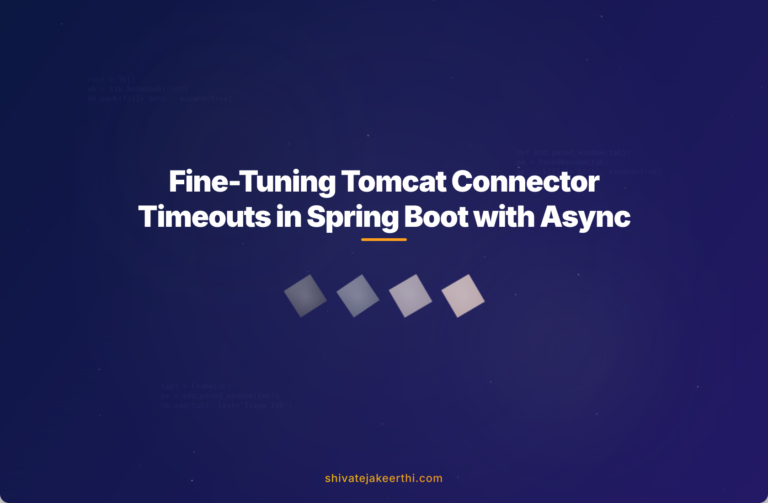When running your Spring Boot application with an embedded Tomcat server, you might encounter scenarios where one specific endpoint requires a longer response time. Maybe you’re handling complex data processing, generating large files, or making external API calls that exceed your default timeout setting.
In such cases, a global timeout increase could negatively impact your application’s performance. To keep things efficient, a better approach is configuring an increased timeout specifically for a single Spring Boot endpoint. Let’s start by clearly understanding Tomcat connector timeout and why it matters.
Understanding Tomcat Connector Timeout
Simply put, a Tomcat connector timeout tells your server how long to wait before giving up on a connection. When a user or client makes a request, Tomcat checks if a response is received within your configured timeout value. If no response comes back within this time, Tomcat cuts the connection off to free up resources.
Why should you care? Because your users expect smooth, reliable experiences. If your timeout is too low, legitimate requests might fail prematurely. If it’s too high, your server could waste resources on inactive or stalled connections.
Adjusting this timeout globally affects every single endpoint in your application. For example, if you set a high timeout across your application, even simple, fast endpoints might unnecessarily tie up resources when something goes wrong. Instead, consider increasing timeouts only for endpoints with extended processing times.
Configuring Tomcat Connector Timeout for a Specific Endpoint
Let’s say you have an endpoint that fetches a massive report from an external data source. Normally, your default timeout is configured at 20 seconds, which suits all your endpoints. But this data-heavy endpoint keeps timing out and needs about a minute to respond fully.
You don’t want your entire application waiting around for requests that may not come back. So, how exactly would you configure the timeout increases for this endpoint specifically?
Here’s the high-level strategy:
- Clearly identify the endpoint needing extra response time.
- Use Spring Boot’s servlet-level configuration (async processing or async-supported servlet methods) to individually increase timeout.
Implementation in Spring Boot
Let’s demonstrate exactly how you can handle increasing the timeout for one specific endpoint using Spring Boot’s asynchronous request processing.
Suppose your endpoint is at /api/large-report. First, annotate your controller method with @GetMapping and clearly mark it as asynchronous using Spring’s @Async annotation or Spring’s DeferredResult.
Here is an example using DeferredResult:
@RestController
public class ReportController {
@GetMapping("/api/large-report")
public DeferredResult> getLargeReport() {
// Increase timeout specifically for this request (e.g., 60 seconds)
DeferredResult> deferredResult = new DeferredResult<>(60000L);
// Handle timeout situation explicitly
deferredResult.onTimeout(() -> {
deferredResult.setErrorResult(
ResponseEntity.status(HttpStatus.REQUEST_TIMEOUT)
.body(null)
);
});
// Process data asynchronously
CompletableFuture.supplyAsync(this::generateHeavyReport)
.thenAccept(report -> {
deferredResult.setResult(ResponseEntity.ok(report));
});
return deferredResult;
}
private Report generateHeavyReport() {
// simulate heavy processing or data fetching
Thread.sleep(45000); // this could be your external call or heavy computation
return new Report("Detailed data...");
}
}
This snippet effectively gives your endpoint more breathing room without changing timeout settings globally. DeferredResult gives you control and flexibility. If the method takes longer than 60 seconds, it’ll trigger the onTimeout() handler and gracefully respond back to the client.
Testing the Changes Effectively
You can quickly validate the result using tools like Postman or your browser. To simulate slow responses, introduce intentional delays with methods like Thread.sleep() during initial testing to ensure your timeout logic works as expected.
Monitor your server logs to confirm the timeout setting is correctly applied to your selected endpoint only, without affecting other fast endpoints.
Best Practices for Configuring Connector Timeout
Timeouts can make or break a good user experience. By following some simple best practices below, you can efficiently manage your connector timeouts without sacrificing application performance:
- Befriend Async Processing: Utilize asynchronous request handling, as shown above, leveraging Spring Boot’s built-in tools.
- Monitor & Review Logs: Regularly check your logs and monitoring tools to verify the effectiveness of your timeout configurations.
- Avoid Unnecessarily High Timeouts: Avoid increasing the timeout too liberally on endpoints. Timeouts should reflect realistic usage and potential maximum processing periods.
- Clearly Handle Timeout Responses: Always handle timeout scenarios gracefully, providing meaningful responses to clients, avoiding unclear errors.
Common Pitfalls to Avoid
Avoid these common issues when adjusting connector timeouts:
- Global Timeout Changes: Don’t apply longer timeouts globally when not required. It ties resources unnecessarily.
- No Handling for Timeouts: Failing to explicitly handle timeout exceptions can confuse users and complicate debugging.
- Excessive Asynchronous Operations: Keep Async processing limited to where it truly matters. Overuse of Async mechanisms unnecessarily complicates debugging and maintenance.
Wrapping It All Up
Adjusting your Tomcat connector timeout for a specific Spring Boot endpoint provides a targeted, efficient way to deal with resource-intensive operations. This solution lets you provide users with responsive experiences on endpoints that typically respond quickly while avoiding frustrating timeouts on those legitimate but slower processes—like file exports or heavy database queries.
Keeping connector timeout management precise and targeted positively impacts application reliability and user satisfaction. Always remember to test thoroughly, monitoring your application’s response to ensure your chosen timeout options genuinely help optimize your application’s overall performance.
Looking to learn more about improving your Java or JavaScript applications? Check out additional useful resources such as our comprehensive JavaScript articles for front-end integrations and related optimizations.
Have you faced timeout configuration challenges in Spring Boot before, and how did you handle them? Let us know your approach in the comments!



0 Comments